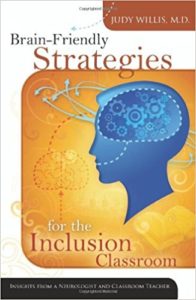A MiddleWeb Blog
Spring is in the air! And that’s not all! Many students begin to feel the end of the school year and the beginning of summer vacation fast approaching… and we all know what that means.
Who’s paying attention in your class? It’s very likely that attention issues may escalate as we feel the transition into the final weeks of school. So, co-teachers… take charge of co-creating an environment where your students – all students – will be more motivated and focused throughout the remaining weeks of this school year.
This post is inspired by the work and insights of Judy Willis – neurologist, teacher, and author – and specifically her book on brain-friendly strategies (which I highly recommend as a meaningful summer read!).
 So what can teachers do about it? Plenty! According to Judy Willis, in her book Brain Friendly Strategies for the Inclusion Classroom, many students with attention needs typically do not reach the level of focus required to stimulate their executive function skills in order for meaningful and long-lasting learning to take place.
So what can teachers do about it? Plenty! According to Judy Willis, in her book Brain Friendly Strategies for the Inclusion Classroom, many students with attention needs typically do not reach the level of focus required to stimulate their executive function skills in order for meaningful and long-lasting learning to take place.
Now let’s add the excitement of the approaching end of the school year, and teachers have more reasons to consider their instructional decisions for all learners. Before we talk strategies, let’s grasp a deeper understanding for what paying attention involves. Willis shares three levels of attention we should consider.
Levels of Attention
Survival mode: Paying attention to our environment – acknowledging whether we feel safe, secure, and comfortable. Students who feel stressed, confused, or completely detached and unmotivated may tend to stay in survival mode. So, co-teachers! Think about the seating arrangements, the pacing, the clarity of directions, the strategies embedded within the process of each lesson – so that you may naturally create a learner-centered, active, and meaningful learning environment.
 https://www.middleweb.com/wp-content/uploads/2017/05/cm-butterfly-768x576.jpg 768w, https://www.middleweb.com/wp-content/uploads/2017/05/cm-butterfly-4... 453w, https://www.middleweb.com/wp-content/uploads/2017/05/cm-butterfly-6... 600w, https://www.middleweb.com/wp-content/uploads/2017/05/cm-butterfly.jpg 800w" sizes="(max-width: 270px) 100vw, 270px" />Interest mode: Learners pay attention to what interests them. Students engage in novelty and topics of personal interest. Co-teachers! Think about how you may embed elements of surprise through creatively planned lessons for an active, relevant learning process.
https://www.middleweb.com/wp-content/uploads/2017/05/cm-butterfly-768x576.jpg 768w, https://www.middleweb.com/wp-content/uploads/2017/05/cm-butterfly-4... 453w, https://www.middleweb.com/wp-content/uploads/2017/05/cm-butterfly-6... 600w, https://www.middleweb.com/wp-content/uploads/2017/05/cm-butterfly.jpg 800w" sizes="(max-width: 270px) 100vw, 270px" />Interest mode: Learners pay attention to what interests them. Students engage in novelty and topics of personal interest. Co-teachers! Think about how you may embed elements of surprise through creatively planned lessons for an active, relevant learning process.
Selective mode: As students achieve this highest level of attention, they are able to focus on important details and work through challenges as they question, consider solutions, and collaborate to draw conclusions and stay motivated to put forth the effort to embrace all steps of the learning process.
Students are intrinsically motivated as they experience the selective mode of attention. Learners are immersed in the desire to learn because the learning environment in safe, secure, and interesting in ways that encourage them to personally access and connect with the content. So how do we get more students to enter and remain in selective mode of attention?
Strategies to Increase Intrinsic Motivation and a High Level of Attention
Provide Choice: Embed choice in any way that works to guide learners to achieve the learning goal(s). For example, invite students to work in pairs, small groups, or solo. Invite students to select from a list of vocabulary words, math problems, or other content area material—where they choose a specified number out of the total provided.
 https://www.middleweb.com/wp-content/uploads/2015/05/raised-hands-color.jpg 320w" sizes="(max-width: 250px) 100vw, 250px" />Guide Learners to Take Charge: Create the lesson with the students. For example, as you introduce the lesson, apply effective questioning to involve their voice and actions in decisions to keep the lesson flowing in personal and meaningful ways.
https://www.middleweb.com/wp-content/uploads/2015/05/raised-hands-color.jpg 320w" sizes="(max-width: 250px) 100vw, 250px" />Guide Learners to Take Charge: Create the lesson with the students. For example, as you introduce the lesson, apply effective questioning to involve their voice and actions in decisions to keep the lesson flowing in personal and meaningful ways.
Increase Student Inquiry and Discovery: Apply questioning techniques to any lesson to model and strengthen students’ ability to ask questions and seek solutions. Find ways to embed opportunities for inquiry based, project based learning opportunities.
Provide Time: Apply strategies like the 3-minute pause to give learners time to process the content in ways that increase meaningful connections.
Accentuate the Positive: Catch students in the moments of attention and provide specific feedback to embed that feeling of success and guide their motivation to keep on pushing through natural challenges within the learning process.
 Embed Cues: Get creative. Make connections with students to cue their attention. For example, one student may respond to visual cues – to include a thumbs up gesture. Or make eye contact and nod to validate, demonstrate, and nudge students to self-regulate their attention and focus. Other students may respond best to the presence of proximity as you walk around the room to increase auditory, visual, and physical prompts.
Embed Cues: Get creative. Make connections with students to cue their attention. For example, one student may respond to visual cues – to include a thumbs up gesture. Or make eye contact and nod to validate, demonstrate, and nudge students to self-regulate their attention and focus. Other students may respond best to the presence of proximity as you walk around the room to increase auditory, visual, and physical prompts.
Make Use of Brain Breaks: Similar to the 3-minute pause strategy – embed moments when students may just take a breath and process any information. Or simply take a mindful pause. This break could be all the difference between detaching and withdrawing to staying attentive and energized to keep on learning within. Check out these quick, effective brain energizers!
With weeks left in this school year, what are you doing to ensure your students are in their selective mode for their personal-best optimal attention? Please share your ideas in the comments section below and also drop a tweet on Twitter to share with our hashtag #CoTeachat!

You need to be a member of School Leadership 2.0 to add comments!
Join School Leadership 2.0